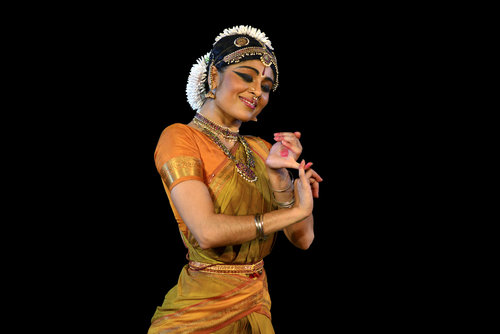Artist Spotlight: Ragamala Dance Company's Ashwini Ramaswamy
/Meet the incredibly talented Ashwini Ramaswamy of Ragamala Dance Company. Under the direction of Ranee Ramaswamy and Aparna Ramaswamy, Ragamala Dance Company’s work explores the dynamic tension between the ancestral and the contemporary.
Hello Ashwini, thank you very much for taking the time from your busy performance schedule to speak with us! Can you tell us what art form Ragamala teaches and a little about your background?
Bharatanatyam is a classical dance form from southeastern India that has evolved through its practitioners. The name Bharatanatyam derives from the four most important aspects of dance (in Sanskrit). These are: Bha from Bhava meaning emotion, Ra from Raaga meaning music or melody, Ta from Taala meaning rhythm and Natyam meaning dance. It is an integral part of Indian culture due to its multi-dimensionality, integrating elements of music, movement, theater, philosophy, and psychology.
I come from a family of dancers, and dance and family are inextricably linked. Our ambition has always been to show that this culturally specific practice transcends classification to tap into an inner spirituality that is universal. We are committed to circumventing notions that culture-based forms are impenetrable, and continue to seek answers about how humans receive, interpret, and create across generation and culture.
Do you remember when you first became interested in dance and music? How did it happen? Did you have any big influences?
The two worlds of India and the United States have always overlapped for me because my sister and mother were born in India and I spent my adolescence within both countries. Bharatanatyam has always been a part of our lives, especially since meeting our guru—the legendary dancer/choreographer Smt. Alarmél Valli—who lives in Chennai, India. One of the greatest practitioners of Bharatanatyam, she is a touchstone of inspiration and continual learning for all three of us. She is definitely our biggest influence, but as global citizens, myriad influences guide our work and daily practice. Music, poetry, literature, articles, visual art, and movement practices from around the world constantly inspire us.
As a member of the founding family of Indian dance company Ragamala, can you tell us how it was started?
My mother, Ranee Ramaswamy, founded Ragamala Dance Company (which translates to ‘garland of melodies’) in 1992. Together with my sister, Aparna, she was singularly focused on introducing and educating audiences unfamiliar to Indian dance and showing them how dynamic, complex, yet universal Bharatanatyam could be. Over the past 25 years, the company has become known for thoughtful yet unexpected artistic partnerships that shed light on the cultural diversity that is the backbone of current human life.
What are some of the goals for the group’s performances? What do you hope the audience gets out of it?
Live artistic experiences such as dance and music allow us to communicate across boundaries of culture and geography. Ragamala’s work brings together artists from different backgrounds to create a meaningful experience, allowing the audience to come away with awe and empowerment. Each project takes several years to create—through constant dialogue, careful thought, research, and personal reflection—to make absolutely sure that our voices are coming out through our work.
Bharatanatyam is the externalization of internal emotions, philosophies, and thoughts. The dancer must become completely absorbed in his or her dancing in order to make a meaningful connection with the audience. It is always our intention and hope that the performance will make that emotional impact on the viewer. When a newcomer comes to see us, we hope that they can see beyond the costuming and makeup, and that they focus on the visceral emotions and universality of the art form. What we do is ancient in origin but not in content – we present completely original work that combines a contemporary Western aesthetic with an Indian ethos.
Do you have any new projects coming up?
Our newest work, Body, the Shrine, premieres at the Cowles Center in Minneapolis at the end of April. This is the first time the three Ramaswamy women are collaborating on an evening-length work together. In this piece, choreography, mythography, and Bhakti poetry entwine to connect the spiritual, the immediate, the intimate, and the transcendent. ‘Bhakti’ is a Sanskrit term meaning both ‘devotion’ and ‘participation.’ Accompanied by a musical ensemble from South India, Body, the Shrine draws its title from a 12th-century Hindu poem by the poet Basavanna, which reads:
“My legs are pillars,
The body the shrine,
The head a cupola
Of gold.
Listen, O lord of the meeting rivers,
Things standing shall fall,
But the moving ever shall stay”
In Bharatanatyam, the body is a moving temple and the dancer becomes a vehicle to communicate a full range of human emotions, allowing the performers to explore the sacred sanctuary that exists within each of us.
Ragamala has been on the COMPAS roster for close to 20 years now. What’s it like for you to be a part of COMPAS?
It’s always so rewarding to be able to share our work with young people. They receive art in a way that that is so different from the way adults do—with innocence and without preconceived notions—and so often ask questions that we could never anticipate!
Through COMPAS, we’ve been able to bring Bharatanatyam—and with it, the arts and culture of India, and our own perspectives as first- and second-generation Indian-American artists—to hundreds of classrooms throughout Minnesota. Even before Ragamala was on the roster, my mom was a COMPAS roster artist. As a young immigrant newly arrived in Minnesota, she traveled to K-12 schools throughout the state, introducing young people—in what were, at the time, ethnically homogeneous areas—to her culture, her art form, and her experience.
By working with kids, we not only expand their perceptions of the world around them, but we’re also building the audiences of the future.
How do you practice creativity in your everyday life?
Exploring creativity is an innate part of our daily lives as dancemakers. We are constantly creating new work, refining existing work, brainstorming new work, or finding inspiration for future work. There is creativity in everything around us – architecture, cuisine, the appreciation of nature – to walk through life as an active participant and enjoy its idiosyncrasies is to be creative.






